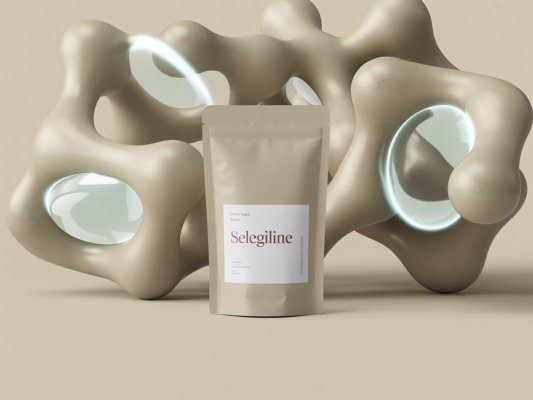
Selegiline
Description
Selegiline is a medication primarily used to manage the symptoms of Parkinson's disease. It belongs to a class of drugs known as monoamine oxidase type B (MAO-B) inhibitors, which work by increasing the amount of dopamine in the brain. This article provides a comprehensive, yet accessible overview of Selegiline, including its uses, dosage, side effects, and potential interactions.
Quick Overview: Selegiline At-a-Glance
- Key Benefit: Primarily used to manage symptoms of Parkinson's disease.
- Primary Mechanism: Selectively inhibits monoamine oxidase type B (MAO-B) in the brain, preventing the breakdown of dopamine.
- Best For: Individuals with Parkinson's disease who need assistance managing their symptoms, often used in conjunction with levodopa.
- Typical Dose Range: 5 mg twice daily or 1.25mg - 2.5 mg daily for oral disintegrating tablets.
- Key Caution/Consideration: Potential for serious drug interactions, including risk of serotonin syndrome and hypertensive crisis.
Table of Contents
Categories & Effectiveness
Learn about our rating methodologyBrain Health
Dopamine Support
10/10Strong evidence of effectiveness
Brain Antioxidant Shield
7/10Strong evidence of effectiveness
Neuro-Repair Support
7/10Strong evidence of effectiveness
Neurogenesis (BDNF/NGF)
7/10Strong evidence of effectiveness
Mood & Stress
Mood Elevation
7/10Strong evidence of effectiveness
Systemic Health
Cellular Repair
7/10Strong evidence of effectiveness
Systemic Antioxidant
4/10Moderate evidence of effectiveness
Dosage & Side Effects
Recommended Dosage
Those with renal impairment should use caution with tablets and capsules, and orally disintegrating tablets are not recommended for severe renal impairment. For hepatic impairment, reduce the dose of orally disintegrating tablets to 1.25 mg daily in mild to moderate cases; it's not recommended in severe cases.
Potential Side Effects
Rarely, Selegiline may cause severe allergic reactions, hallucinations, depression, tremors, chest pain, trouble breathing, suicidal thoughts/behavior, irregular heartbeat, or severe headache. If you experience any of these serious side effects, seek immediate medical attention.
Bioavailability & Half-Life
Interactions & Stacks
Recommended Products
SOLGAR® Folat (als Metafolin®) 400mcg, auch bekannt als Vitamin B9 | Bei Kinderwunsch, Schwangerschaft & Stillzeit und veganer Ernährung | 100 vegane Tabletten
- Rated 4.7 stars by 35 customers
- Premium quality ingredients
ESN Athlete Stack Men, 210 Kapseln, alle essentiellen Vitamine und Mineralstoffe, vegan - made in Germany
- Rated 4.5 stars by 882 customers
- Special offer: 10 % Rabatt auf deine erste Abonnement-Bestellung
Biotin + Selen + Zink für Haut, Haare & Nägel - 365 vegane Tabletten - Ohne Magnesiumstearat, laborgeprüft & in Deutschland produziert
- Rated 4.4 stars by 9,277 customers
- Premium quality ingredients
As an Amazon Associate we earn from qualifying purchases. Prices and availability are accurate as of the date/time indicated and are subject to change.
Benefits by Use Case
Parkinson's Disease Symptom Management
Selegiline helps manage motor symptoms like tremors, rigidity, and bradykinesia by increasing dopamine levels in the brain. It is often used as an adjunct to levodopa to improve its effectiveness and reduce motor fluctuations. However, it does not cure Parkinson's disease or halt its progression.
Mood Elevation
Selegiline may improve mood and reduce depressive symptoms in some individuals. This effect is likely related to its ability to increase dopamine and other monoamine neurotransmitters in the brain. However, it is not a primary treatment for depression and should be used with caution due to the risk of serotonin syndrome.
Mechanism of Action
Frequently Asked Questions
Where to Buy Selegiline
Based on quality, price, and customer reviews, here are our top recommended Selegiline supplements:
Probiona Komplex – perfekt aufeinander abgestimmte Bakterienstämme – 300 Mrd. KBE/g – magensaftresistent & vegan – mit Lactobacillus & Bifidobakterien, hochdosierte 20 Mrd KBE/Tagesdosis, 3 Monate
- Rated 4.4 stars by 12,676 customers
- Premium quality ingredients
Biotin + Selen + Zink für Haut, Haare & Nägel - 365 vegane Tabletten - Ohne Magnesiumstearat, laborgeprüft & in Deutschland produziert
- Rated 4.4 stars by 9,277 customers
- Premium quality ingredients
ESN Athlete Stack Men, 210 Kapseln, alle essentiellen Vitamine und Mineralstoffe, vegan - made in Germany
- Rated 4.5 stars by 882 customers
- Special offer: 10 % Rabatt auf deine erste Abonnement-Bestellung
As an Amazon Associate we earn from qualifying purchases. Prices and availability are accurate as of the date/time indicated and are subject to change.
Summary & Expert Opinion
Key Strengths: Proven for Parkinson's symptom management, potential in atypical depression.
Key Weaknesses: Risk of significant drug interactions (serotonin syndrome, hypertensive crisis), potential for side effects.
Recommendation: Effective for managing Parkinson's symptoms as part of a comprehensive treatment plan; requires careful monitoring and awareness of potential interactions.
From a more technical perspective, Selegiline's action extends beyond simple MAO-B inhibition. While the primary mechanism involves preventing dopamine breakdown, it also appears to have antioxidant and anti-apoptotic effects in preclinical studies. The selective inhibition of MAO-B is dose-dependent; at higher doses, Selegiline can also inhibit MAO-A, increasing the risk of side effects. The metabolism of Selegiline is complex, producing L-methamphetamine and L-amphetamine, which may contribute to some of its stimulant-like side effects. The slow recovery of MAO-B after Selegiline withdrawal (around 40 days half-time) suggests that lower doses may be effective and could reduce side effects. The use of transdermal formulations aims to bypass first-pass metabolism, potentially improving bioavailability and reducing the formation of amphetamine metabolites. However, such formulations may also increase the risk of MAO-A inhibition. The exploration of multifunctional propargylamine derivatives represents an interesting avenue for developing more targeted and effective treatments for neurodegenerative diseases. These derivatives combine MAO inhibition with other beneficial activities, such as metal chelation and antioxidant effects.








